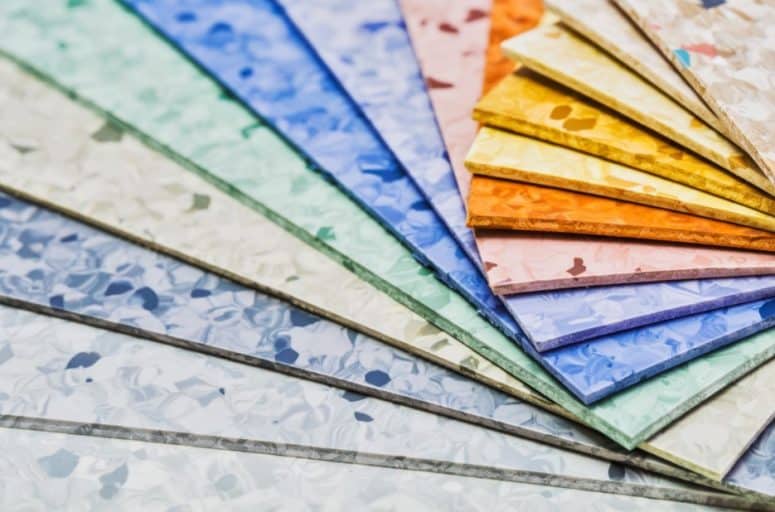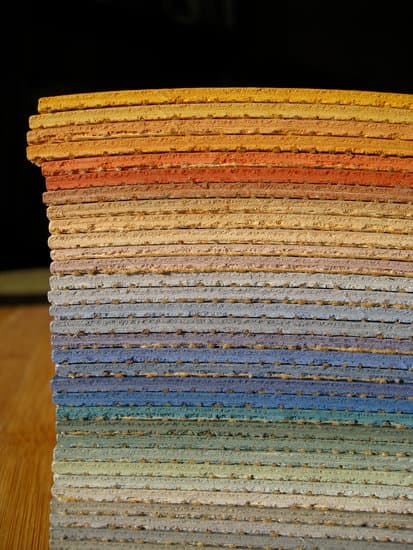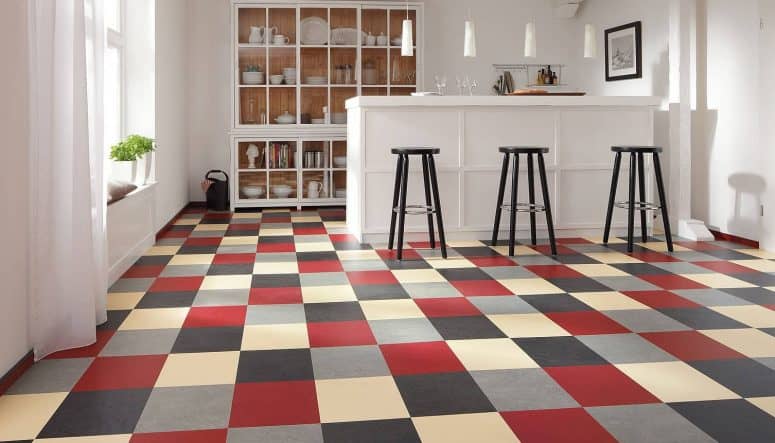Linoleum flooring is often mistaken for vinyl flooring due to their similar appearance. However, they differ significantly in their composition and characteristics.
Unlike vinyl flooring, which is primarily made from synthetic materials such as PVC, linoleum flooring is a much more natural option. It is composed of linseed oil, tree resins (typically from pine trees), cork powder, and mineral pigments.
These natural materials give linoleum flooring its distinctive texture and resilience, setting it apart from vinyl.
Here, you’ll find comprehensive information about linoleum flooring, including its strengths and weaknesses, enabling you to make informed decisions regarding its suitability for your needs.
Linoleum Floors Materials

In our previous discussion, we touched upon the general composition of linoleum flooring, highlighting its use of natural resources. Now, let’s delve into more specific details about the materials used in different layers.
- Wear Layer: The wear layer is the protective coating applied on the surface of linoleum flooring. It is typically included as part of the flooring product when you purchase it.
- Image Layer: Unlike other types of flooring, linoleum does not have a separate image layer. Instead, the image layer is embedded throughout the material, blended with the core layer. This integration gives the flooring a cohesive appearance.
- Base Layer (Core): The core layer of linoleum flooring is composed of compressed materials. It incorporates linseed oil, cork flour or dust, and mineral pigments. These elements work together to create a smooth surface and bring out the embedded image layer.
It’s important to note that linoleum flooring is not constructed with distinct layers. Rather, it is a compressed form of resilient flooring that combines natural and biodegradable materials. Some linoleum products may also include an additional top coating to enhance durability and quality.
Linoleum Flooring Pros & Cons

Let’s dive into one of the key aspects that people often seek when exploring flooring options: the pros and cons of linoleum flooring. While linoleum flooring boasts its all-natural materials, it’s essential to weigh the advantages and disadvantages before making it your flooring choice.
The Pros of Linoleum Flooring
Eco-consciousness is at the forefront when it comes to linoleum flooring, as it is made from biodegradable materials that pose no harm to the environment, even in landfills.
In addition to its eco-friendly nature, linoleum flooring is also friendly to your budget. Its remarkable durability ensures that you can enjoy its benefits for years to come, often backed by warranties of up to 25 years, and with proper care, it can even last up to 40 years.
Maintenance of linoleum flooring is a breeze, requiring simple tasks such as regular sweeping to remove dust and routine mopping for a thorough clean. Unlike wood flooring, linoleum’s wood-like appearance doesn’t demand extensive maintenance, making it an attractive and practical choice.
The beauty of linoleum flooring goes beyond its environmental and budget-friendly qualities. Its captivating look is sustained throughout the material, thanks to the presence of mineral pigments that infuse vibrant hues into every layer.
With its durability, easy maintenance, and stunning aesthetics, linoleum flooring truly exemplifies the perfect combination of functionality and beauty.
The Cons of Linoleum Flooring
While linoleum flooring offers numerous advantages, it’s important to be aware of some potential drawbacks. Linoleum is susceptible to damage from sharp objects, such as high heels, which can cut or puncture its surface.
Moreover, linoleum is not an ideal choice for areas prone to moisture, like bathrooms or wet areas, as water can easily damage its surface and layers. Careful consideration is necessary when selecting the appropriate location for linoleum installation.
In terms of its natural state, linoleum flooring typically does not come with a protective coating. Without this coating, linoleum is vulnerable to fading when exposed to sunlight. To address this issue, many people opt for linoleum with a protective coating.
However, it’s worth noting that freshly coated linoleum flooring can be slippery, posing a potential hazard when walked upon. Caution should be exercised when encountering a newly coated linoleum surface.
Where should linoleum flooring be used?

Linoleum flooring offers great versatility, making it suitable for a wide range of rooms. Its soft texture provides a comfortable feel underfoot, akin to a cozy cushion. This not only enhances your comfort but also reduces noise compared to vinyl flooring.
Additionally, the availability of various designs, colors, and textures makes linoleum a popular choice for many homeowners. Whether it’s your bedroom, workspace, or house corridors, linoleum can complement these spaces beautifully. It can withstand light to heavy foot traffic, ensuring its durability.
Notably, linoleum flooring is waterproof, which makes it a viable option for areas like kitchens. However, it’s important to note that it has limitations when exposed to excessive water, particularly in wet areas. Therefore, while linoleum is suitable for kitchen installations, it’s essential to consider specific recommendations for optimal performance and longevity.
The Cost of Linoleum Flooring
When it comes to pricing, linoleum flooring is comparable to vinyl flooring, despite having different materials. Linoleum flooring is available in three forms: planks, tiles, and sheets, each with its own price range.
Plank linoleum typically costs between $4 and $6 per square foot. Sheets and tiles, on the other hand, range from $2.50 to $3.50 per square foot. Although the price difference is not substantial, planks tend to be slightly more expensive.
Installation of linoleum planks and tiles can be done as a DIY project, saving you additional costs. However, for linoleum sheets, it is recommended to hire professionals due to the complexity of the installation process. Incorrect methods can result in curling or wrinkling of the linoleum sheets on the floor.
Professional installation typically incurs an extra cost, ranging from $700 to over $2000. The specific cost depends on the difficulty of the installation and the size of the room.
Do I need Subfloor / Underlayment?
The installation of linoleum flooring typically does not require a subfloor or underlayment. In the case of linoleum planks, they often come with a convenient snap-together feature on the edges, allowing for easy DIY installation without the need for gluing or nailing.
However, installing linoleum sheets can be more challenging. Some people choose to use a subfloor or underlayment to ensure a more even and level base for the flooring. Using a subfloor or underlayment can help create a stable foundation for the linoleum.
To install an underlayment, you would need to level it properly and leave a gap of 1 to 3 inches between the subfloor and the linoleum floor. This gap allows for natural expansion of the linoleum after installation.
By following these steps, you can ensure a proper and sturdy installation of your linoleum flooring.
How Durable Are Linoleum Floors?
Manufacturers typically provide a 25-year warranty for linoleum flooring, but with proper care and maintenance, it can actually last up to 40 years. This lifespan surpasses that of vinyl flooring, which may appear similar to linoleum but falls into the resilient flooring category.
However, to achieve this extended lifespan, linoleum flooring requires specific attention in certain areas. One aspect to consider is the process of ambering, which refers to the floor developing a yellowish tint due to exposure to sunlight. To prevent this, it is advisable to apply a protective coating that can be obtained from the manufacturer or the place where you purchased the flooring.
Additionally, it is important to be cautious of sharp objects and excessive water spills. Linoleum flooring is not resistant to sharp elements such as high heels, especially in high-traffic areas, as they can cause damage. While linoleum is waterproof, excessive water on the surface can lead to accelerated wear and tear of the layers, shortening the overall lifespan of the flooring. Therefore, it is crucial to control water spills to maintain the longevity of the linoleum flooring.
Linoleum Flooring Maintenance
Great news! Maintaining and cleaning linoleum flooring is a breeze compared to other flooring options. The best part is that you can easily keep your linoleum floor looking its best with a few simple steps.
First and foremost, regular cleaning is key. Use mild, non-ammonia-based flooring cleansers to protect the protective coating of the linoleum. Heavy detergents can potentially harm the material, so stick to gentle options. Additionally, sweeping or lightly vacuuming the floor will help remove dust and dirt, keeping your linoleum clean and fresh.
For deeper cleaning, a damp mop with warm water and a mild detergent is all you need. Using a soft rag and mild detergent is highly recommended for tackling stains effectively.
Now, let’s address the concern of ambering caused by sunlight exposure. To prevent your authentic, eco-friendly linoleum flooring from yellowing, it’s important to wax the floor every two or three years. Waxing not only helps maintain the floor’s appearance but also provides protection against scratches and excessive water spills.
By following these simple cleaning and maintenance practices, you can ensure your linoleum flooring stays vibrant, protected, and beautiful for years to come.